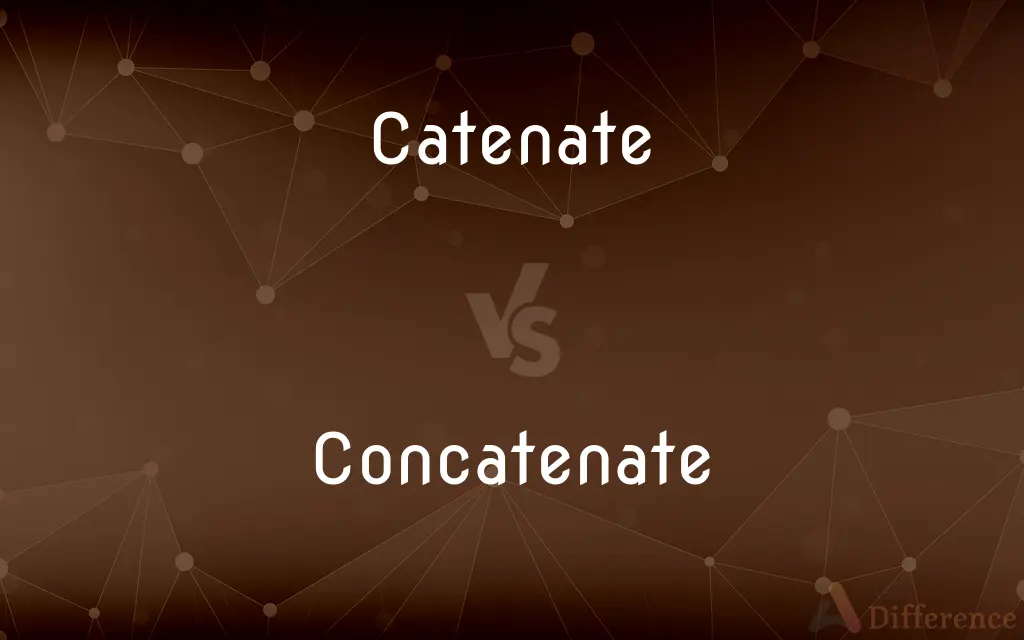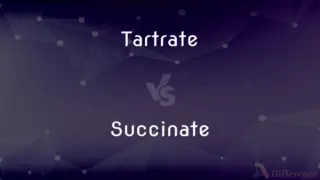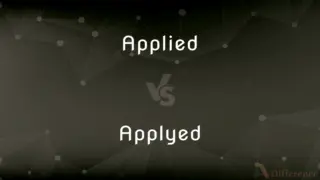Catenate vs. Concatenate — What's the Difference?
By Urooj Arif & Fiza Rafique — Updated on April 7, 2024
Catenate refers to linking in a series or chain, while concatenate involves joining together in a series or sequence, often used in computing.

Difference Between Catenate and Concatenate
Table of Contents
ADVERTISEMENT
Key Differences
Catenate and concatenate are terms used to describe the action of linking or joining things together, but they are applied in slightly different contexts and disciplines. Catenate, derived from the Latin word "catena" meaning chain, generally refers to the act of linking things in a series or chain-like fashion. It is often used in a more general sense and can apply to various forms of physical, chemical, or metaphorical linking. Whereas concatenate is more specifically used in computing and data processing to describe the operation of joining together two or more strings, arrays, or lists in a sequence to form a single entity.
In chemistry, to catenate is to link atoms through bonds in a chain or ring structure, showcasing the term's application in describing physical connections. On the other hand, in computing, to concatenate strings means to join them end-to-end to form a new string. This illustrates the specificity of concatenation in dealing with sequences of characters or data.
While catenate might be used more broadly across different fields, concatenate is particularly prevalent in programming languages, databases, and information processing, where it refers to a precise operation performed on data. This highlights the difference in their technical application and the contexts in which they are most commonly used.
The concept of catenation is essential in understanding molecular structures and mechanisms in chemistry, emphasizing the physical bonding and arrangement of atoms. Conversely, concatenation plays a critical role in data manipulation and string handling in software development, emphasizing the logical combination of data elements.
Both catenation and concatenation involve the idea of joining or linking elements; however, their use and significance vary across different disciplines. By distinguishing between these terms, one can appreciate the nuanced ways in which connections and sequences are formed, whether in molecular chains or data strings.
ADVERTISEMENT
Comparison Chart
Definition
To link in a series or chain.
To join together in a series or sequence.
Primary Use
General, broad application across various fields.
Specific to computing and data processing.
Examples
Chemical bonds in molecules, physical chains.
Joining strings or arrays in programming.
Disciplines
Chemistry, general discourse.
Computing, programming, information technology.
Outcome
A chain-like structure or sequence.
A single string, list, or array formed from multiple elements.
Compare with Definitions
Catenate
Broadly applicable across different contexts.
The system catenates user inputs for processing.
Concatenate
Specifically used in programming and data manipulation.
Concatenating arrays can simplify data handling.
Catenate
Refers to the formation of a series of interconnected items.
The artist catenated the paper clips into an intricate sculpture.
Concatenate
Involves creating a new entity from existing elements.
The script concatenates multiple text files into one.
Catenate
To link together in a chain or series.
The process can catenate molecules into a long chain.
Concatenate
Focuses on the sequential joining of data elements.
The function concatenates input strings with a delimiter.
Catenate
Used to describe chain formations in chemistry.
Carbon atoms can catenate to form various complex structures.
Concatenate
To join together strings, arrays, or lists in computing.
The program concatenates the first and last names into a full name.
Catenate
Implies a physical or metaphorical connection between elements.
The narrative catenates events across different epochs.
Concatenate
A function or operation in software development.
The database query concatenates fields to generate reports.
Catenate
To connect in a series of ties or links; form into a chain.
Concatenate
To connect or link in a series or chain.
Catenate
To connect things together, especially to form a chain.
Concatenate
(Computers) To arrange (strings of characters) into a chained list.
Catenate
To connect, in a series of links or ties; to chain.
Concatenate
Connected or linked in a series.
Catenate
Arrange in a series of rings or chains, as for spores
Concatenate
To join or link together, as though in a chain.
Concatenate
To join (text strings) together.
Concatenating "shoe" with "string" yields "shoestring".
Concatenate
(biology) Joined together as if in a chain.
Concatenate
To link together; to unite in a series or chain, as things depending on one another.
This all things friendly will concatenate.
Concatenate
Arranged into chained list
Concatenate
Add by linking or joining so as to form a chain or series;
Concatenate terms
Concatenate characters
Common Curiosities
Can catenate be used in programming?
While not commonly used in programming, catenate can describe the conceptual action of linking elements. However, concatenate is the preferred term.
What is concatenation in computing?
Concatenation in computing refers to the operation of joining two or more strings, arrays, or lists to form a single sequence.
How do catenate and concatenate differ?
Catenate is used more broadly to describe any form of linking in a series, whereas concatenate specifically refers to joining data elements in computing.
Why is concatenation important in software development?
Concatenation is crucial for manipulating and processing strings and data structures, enabling developers to efficiently combine data for various applications.
How is concatenation performed in programming languages?
Most programming languages provide built-in functions or operators to concatenate strings or arrays, such as the + operator in Python or the concat() method in JavaScript.
Can concatenation affect data type?
Yes, concatenating different data types might require conversion, especially in strongly typed programming languages, to ensure compatibility.
Can objects other than strings be concatenated?
Yes, in many programming languages, arrays, lists, and sometimes other data structures can also be concatenated to form larger sequences.
What are examples of catenation outside of chemistry?
Examples include the linking of historical events in a narrative or the physical linking of objects to create art or utility items.
What does it mean to catenate?
To catenate means to link or join things together in a chain or series, either physically or metaphorically.
Is catenation specific to chemistry?
While catenation is an important concept in chemistry, especially regarding carbon chains, the term can be applied in other contexts to describe any form of linking in a series.
What role does concatenation play in databases?
Concatenation is used in databases to combine fields or columns in queries, enhancing data presentation and reporting capabilities.
How do you choose between catenate and concatenate in description?
Choose "catenate" for general or physical linking, especially outside of computing. Use "concatenate" for specific references to joining data in computing contexts.
Can catenation occur naturally?
Yes, in chemistry, catenation occurs naturally when elements like carbon form chains or rings as part of organic compounds.
Are there tools to help with data concatenation?
Most programming environments and text processing tools provide features or libraries specifically designed to facilitate efficient data concatenation.
Is there a performance impact when concatenating large data sets?
Concatenating very large strings or data sets can impact performance, particularly if done repeatedly in a loop, due to memory allocation and copying operations.
Share Your Discovery

Previous Comparison
Tartrate vs. Succinate
Next Comparison
Applied vs. ApplyedAuthor Spotlight
Written by
Urooj ArifUrooj is a skilled content writer at Ask Difference, known for her exceptional ability to simplify complex topics into engaging and informative content. With a passion for research and a flair for clear, concise writing, she consistently delivers articles that resonate with our diverse audience.
Co-written by
Fiza RafiqueFiza Rafique is a skilled content writer at AskDifference.com, where she meticulously refines and enhances written pieces. Drawing from her vast editorial expertise, Fiza ensures clarity, accuracy, and precision in every article. Passionate about language, she continually seeks to elevate the quality of content for readers worldwide.














































